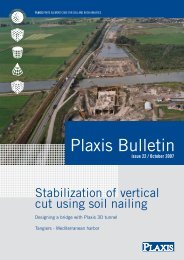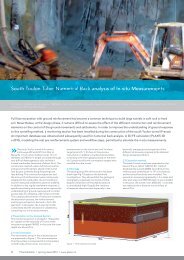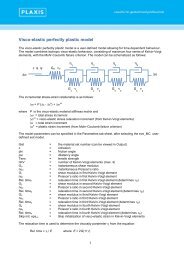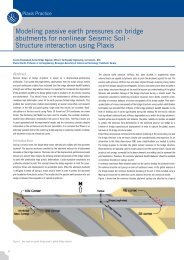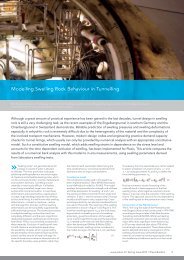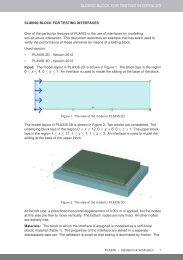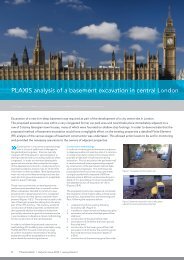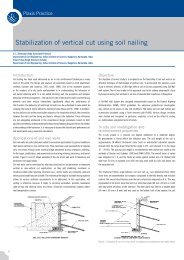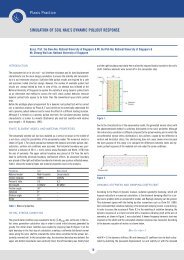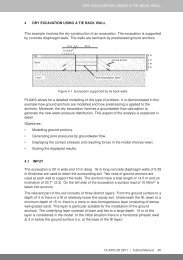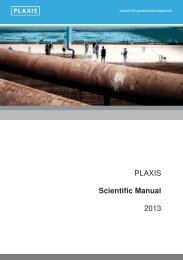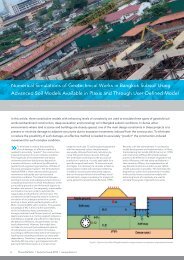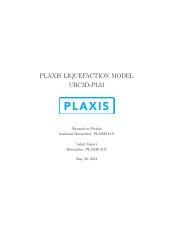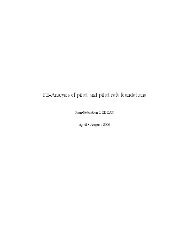Bulletin 12, Summer 2002 - Plaxis
Bulletin 12, Summer 2002 - Plaxis
Bulletin 12, Summer 2002 - Plaxis
Create successful ePaper yourself
Turn your PDF publications into a flip-book with our unique Google optimized e-Paper software.
PLAXIS<br />
PLAXIS<br />
PLAXIS<br />
Nº<br />
<strong>12</strong> - JUNE <strong>2002</strong><br />
Editorial<br />
<strong>Bulletin</strong> of the<br />
PLAXIS<br />
Users Association (NL)<br />
<strong>Plaxis</strong> bulletin<br />
<strong>Plaxis</strong> B.V.<br />
P.O. Box 572<br />
2600 AN Delft<br />
The Netherlands<br />
E-mail:<br />
bulletin@plaxis.nl<br />
IN THIS ISSUE:<br />
Editorial 1<br />
Column Vermeer 2<br />
New developments 4<br />
Note on pore pressure 6<br />
Benchmarking I 9<br />
Benchmarking II <strong>12</strong><br />
Recent Activities 13<br />
<strong>Plaxis</strong> practice I 14<br />
<strong>Plaxis</strong> practice II 17<br />
Users forum 22<br />
Some Geometries 22<br />
Agenda 24<br />
Some time has passed since the appearance<br />
of our last bulletin no 11, but the PLAXIS<br />
team did not sit still. Not only was a new<br />
director appointed for PLAXIS B.V. which<br />
will be introduced further on, also a<br />
number of other new team-members have<br />
come to work for PLAXIS. The <strong>Plaxis</strong>-team<br />
has extended with four new people in<br />
order to improve the capability to<br />
accommodate for the demand on new<br />
plaxis developments. The <strong>Plaxis</strong>-team<br />
consist of 14 people. In the next bulletin,<br />
we will briefly introduce them to you.<br />
New Developments which will be discussed in<br />
the contribution by Dr Brinkgreve, the head of<br />
our development team. He will discuss further<br />
developments such as for the release of <strong>Plaxis</strong><br />
Version 8, the progress on the PLAX-flow<br />
program and the other 3D developments. With<br />
respect to PLAXIS 2D, Version 8 is due to be<br />
expected after the summer holidays, as Beta<br />
testing of this new program is underway, and<br />
the users in our regular PLAXIS course in<br />
Noordwijkerhout in January and also the<br />
attendants of the advanced course have had<br />
some opportunity to experience this new<br />
program.<br />
In his regular column Prof. Vermeer will discuss<br />
the use of soil parameters and especially<br />
parameter estimation. Not always is it possible<br />
to do a direct test for a parameter. Or sometimes<br />
in a pre-design stage there is only limited<br />
information of the soil stratification. In that case<br />
it is often very convenient to have some<br />
correlations between different soil-parameters<br />
in order to be able to proceed with a<br />
geotechnical design. In this issue Prof. Vermeer<br />
discusses Oedometer stiffness of Soft Soils.<br />
In addition to the aforementioned, Prof.<br />
Schweiger who also is a regular contributor to<br />
our bulletin discusses the relation between<br />
Skemptons pore pressure parameters A and B<br />
and the performance of the Hardening Soil<br />
model.<br />
Furthermore we are fortunate to have new<br />
contributions with respect to Benchmarking;<br />
two contributions on benchmarking are<br />
presented here, one on Shield tunnelling and<br />
another on excavations.<br />
Again we are glad to have a number of practical<br />
applications; Among which are a contribution<br />
by Dr. Gysi, on a multi-anchored retaining wall,<br />
and another one by Mr. Cheang from<br />
Singapore on a complicated retaining wall with<br />
Jack-In Anchors.<br />
Finally in the Users Forum it is shown how a<br />
more complicated 3D situation of a Retaining<br />
wall with anchors is practically modelled with<br />
PLAXIS 2D.<br />
Editorial Staff:<br />
Martin de Kant, <strong>Plaxis</strong> Users Association (NL)<br />
Marco Hutteman, <strong>Plaxis</strong> Users Association (NL)<br />
Peter Brand, <strong>Plaxis</strong> B.V.<br />
Scientific Committee:<br />
Prof. Pieter Vermeer, Stuttgart University<br />
Dr. Ronald Brinkgreve, <strong>Plaxis</strong> bv<br />
1
PLAXIS<br />
PLAXIS<br />
Fig. 1:<br />
Atterberg limits of 21<br />
different soils that were<br />
tested by Engel<br />
Column Vermeer<br />
as the modified compression index * and in<br />
C c<br />
addition the oedometer modulus E oed.<br />
*=<br />
C c<br />
(2)<br />
(1+e) In10 4.6<br />
One of the best-known geotechnical<br />
correlations reads C c<br />
0.9 (w L<br />
- 0.1), where w L<br />
ON THE OEDOMETER STIFFNESS<br />
OF SOFT SOILS<br />
is the liquid limit. For details, the reader is<br />
referred to the book by Terzaghi and Peck<br />
(1967). Wroth and Wood (1978) proposed the<br />
For normally consolidated fine-grained<br />
soils, we have the logarithmic compression<br />
law, e = C c<br />
log’, where De is the change<br />
of the void ratio, C c<br />
the compression index<br />
and ’ the vertical effectivestress in onedimensional<br />
compression. The compression<br />
index C c<br />
is measured in oedometer tests,<br />
together with other stiffness related<br />
parameters such as the swelling index and<br />
the preconsolidation stress. In this column<br />
seemingly different correlation C c<br />
1.35I P<br />
,<br />
where I P<br />
is the plasticity index. In reality the<br />
two correlations are virtually identical, as the<br />
plasticity index can usually be approximated as<br />
I P<br />
0.73 (w L<br />
- 0.1). Indeed, with the exception<br />
of sandy silts, data for I P<br />
and w L<br />
tend to be on<br />
a straight line that is parallel to the so-called<br />
A-line in Casagrande’s plasticity chart (see<br />
Fig. 1). On using the I p<br />
-w L<br />
correlation, the<br />
Terzaghi-Peck correlation reads C c<br />
1.23I P<br />
,<br />
I will discuss correlations for the which is very close to the finding of C c<br />
1.35I P<br />
compression index C c<br />
.<br />
by Wroth and Wood. Considering the large<br />
amount of evidence on the correlations,<br />
It should be realized that Terzaghi and other<br />
founding fathers of Soil Mechanics lived in the<br />
C c<br />
1.35I P<br />
and I P<br />
0.73 (wL - 0.1), I conclude<br />
that we may use both<br />
10-log-paper period and their findings have to<br />
be reformulated for use in computer codes. C c<br />
1.35I P<br />
and C c<br />
w L<br />
- 0.1 (1)<br />
Hence, we have to change from a 10-log to a<br />
natural logarithm in order to obtain the<br />
reformulated law,<br />
The latter one is only slightly different from<br />
the earlier one by Terzaghi and Peck and to my<br />
judgement also slightly better. Let us now<br />
e = - ln’, where = C c<br />
ln10. On top of<br />
this it is convenient to use strain instead of<br />
address the modified compression index * as<br />
used in all advanced <strong>Plaxis</strong> models. The<br />
void ratio, which leads to the compression law, relationship between the traditional<br />
where = * ln’, * = (1+e) and is a<br />
finite strain increment. I will address C c<br />
, as well<br />
compression index C c<br />
and the modified one<br />
* is expressed by the equation<br />
The approximation follows for e=1. In general<br />
it is crude to assume e1, but it works within<br />
the context of the correlations for soft soils.<br />
In combination with the correlations for C c<br />
it<br />
leads to:<br />
* 0.3l p<br />
and * 0.2(w L<br />
- 0.1) (3)<br />
For a direct assessment of these correlations,<br />
we will consider data by Engel (2001). This<br />
database contains modified compression<br />
indices for 21 different clays and silts, with a<br />
liquid limit ranging from 0.2 up to 1.1 and a<br />
plasticity index between 0.03 and 0.7, as can<br />
2
PLAXIS<br />
PLAXIS<br />
be seen in Fig. 1. Engel’s data for * leads to<br />
Figures 2 and 3. From Fig. 2 it can be<br />
concluded that the correlation<br />
Let us now consider the oedometer stiffness.<br />
To this end the logarithmic compression law<br />
= * . ln’ can be written in the differential<br />
form d/dln = * and one obtains<br />
d’/ d = ’/ The tangent stiffness in<br />
oedometer-compression, also refered to as<br />
the constrained modulus, is thus proportional<br />
to stress. Hence, E oed<br />
='/*, where E oed<br />
is also<br />
denoted as M or E s<br />
, depending on conventions<br />
in different countries. This linear stress<br />
dependency of soil stiffness is nice for finegrained<br />
NC-soils, but not for coarse-grained<br />
ones. Therefore Ohde (1939) and Janbu (1963)<br />
proposed a generalisation of the form:<br />
ref<br />
E oed<br />
= E oed<br />
('/P ref<br />
) m with P ref<br />
= 100kPa (4)<br />
Fig. 2:<br />
Compression indices as<br />
measured by Engel as a<br />
function of I p<br />
Fig. 3:<br />
Compression indices<br />
correlate nicely with the<br />
liquid limit<br />
* 0.3l p<br />
has some shortcomings. A close<br />
inspection shows that it is nice for clays with<br />
plasticity indices above the A-line in<br />
Casagrande’s plasticity chart, but not for silts<br />
with I p<br />
below the A-line. To include such silts<br />
one could better use the correlation,<br />
* 0.2(w L<br />
- 0.1) as demonstrated in Fig. 3. On<br />
plotting * as a function of the liquid limit, as<br />
done in Fig. 3, it is immediately clear that there<br />
is an extremely nice correlation.<br />
It should also be recalled that the correlation<br />
* 0.2(w L<br />
- 0.1) is not only supported by<br />
Engel’s database, but that it is also fully in line<br />
with the work of Wroth & Wood as well as<br />
Terzaghi & Peck on correlations for C c<br />
.<br />
where m is an empirical exponent. This<br />
equation reduces to the linear stress<br />
dependency of soil stiffness for m=1.<br />
In the special case of m=1, one thus obtains<br />
the logarithmic compression law for finegrained<br />
NC-soils. For coarse grained soils, much<br />
lower exponents of about m=0.5 are reported<br />
by Janbu (1963), Von Soos (2001) and other<br />
researchers.<br />
The above power law of Ohde, Janbu and Von<br />
Soos has been incorporated into the Hardening<br />
Soil Model of the <strong>Plaxis</strong> code. Here it should be<br />
noted that the above authors define<br />
ref<br />
E oed<br />
= v . P ref<br />
, where v is a so-called modulus<br />
number. Instead of the dimensionless modulus<br />
number, the Hardening Soil Model involves<br />
ref<br />
E oed<br />
as an input parameter, i.e. the constrained<br />
modulus at a reference stress of<br />
’= p ref<br />
= 100kPa. For the coming Version 8 of<br />
the <strong>Plaxis</strong> code, we have also considered the<br />
use of alternative input parameters. Instead of<br />
ref<br />
E oed<br />
, we have discussed the modulus number<br />
1/* as well as the modified compression index<br />
itself, as it yields<br />
ref<br />
* P ref<br />
/ E oed<br />
(5)<br />
In fact, this simple relationship between the<br />
oedometer stiffness and the modified<br />
compression index triggered our thinking on<br />
alternative input parameters. Finally we decided<br />
3
PLAXIS<br />
PLAXIS<br />
to go one step further and use the traditional<br />
compression index C c<br />
by implementing the<br />
equations:<br />
New Developments<br />
ref<br />
E oed<br />
= P ref<br />
(1+e) ln10<br />
= . P ref<br />
(6)<br />
* C c<br />
Within the new Version 8, users will have the<br />
choice between the input of E oed<br />
and the<br />
alternative of C c<br />
. Similarly, the so-called swelling<br />
index C s<br />
will be used as an alternative input<br />
parameter for the unloading-reloading stiffness<br />
E ur<br />
. On inputting C c<br />
one also has to prescribe<br />
a value for the void ratio.<br />
Here, a default value of e=1 will be introduced.<br />
This will make the Hardening Soil Model easier<br />
to use in the field of soft soil engineering.<br />
In a few months, <strong>Plaxis</strong> version 8 will be<br />
released. This new 2D program is one of the<br />
results of a recently finished two-years<br />
project on <strong>Plaxis</strong> developments. Another<br />
results of this project is the 3D Tunnel<br />
program, which was released last year. In<br />
this bulletin some new features of <strong>Plaxis</strong><br />
version 8 will be mentioned. The new<br />
features are divided into three groups:<br />
Modeling features, calculation options and<br />
user friendliness.<br />
P.A. Vermeer, Stuttgart University<br />
REFERENCES:<br />
Engel, J., Procedures for the Selection of<br />
Soil Parameters (in German), Habilitation study,<br />
Department of Civil Engineering, Technical<br />
University of Dresden, 2001, 188 p.<br />
Janbu, N., "Soil Compressibility as Determined<br />
by Oedometer and Triaxial Tests", Proceedings<br />
3rd European Conference on Soil Mechanics<br />
and Foundation Engineering, Vol. 1,<br />
Wiesbaden, 1963, pp. 19-25.<br />
Ohde, J. , "On the Stress Distribution in the<br />
Ground" (in German), Bauingenieur, Vol. 20, No.<br />
33/34, 1939, pp. 451-459.<br />
MODELING FEATURES<br />
<strong>Plaxis</strong> (2D) version 8 has several new features<br />
for the modeling of tunnels and underground<br />
structures. Some of these features were<br />
already implemented in the 3D tunnel<br />
program, such as:<br />
Terzaghi, K. and Peck, R. B., "Soil Mechanics in<br />
Engineering Practice", 2nd Ed, John Wiley and<br />
Sons, New York, 1967, 729 p.<br />
Soos von, P., "Properties of Soil and Rock" (in<br />
German), Grundbautaschenbuch, Vol. 1, 6th<br />
Ed., Ernst & Sohn, Berlin, 2001, pp. 117-201<br />
Wroth, C. P. and Wood, D. M. , "The Correlation<br />
of Index Properties with Some Basic<br />
Engineering Properties of Soils", Canadian<br />
Geotechnical Journal, Vol. 15, No. 2, 1987, pp.<br />
137-145.<br />
- Extended tunnel designer, including thick<br />
tunnel linings and tunnel shapes composed<br />
of arcs, lines and corners.<br />
- Application of user-defined (pore) pressure<br />
distribution in soil clusters to simulate grout<br />
injection.<br />
- Application of volume strain in soil clusters<br />
to simulate soil volume loss or<br />
compensation grouting.<br />
- Jointed Rock model<br />
Other new modeling features are aimed at<br />
the modeling of soil, structures and soil<br />
structure interaction:<br />
4
PLAXIS<br />
PLAXIS<br />
- Input of Skempton's B-factor for partially<br />
undrained soil behavior.<br />
- Hinges and rotation springs to model beam<br />
connections that are not fully rigid.<br />
- Separate maximum anchor forces<br />
distinction between extension and<br />
compression).<br />
- De-activation of interface elements to<br />
temporarily avoid soil-structure interaction<br />
or impermeability.<br />
- Special option to create drains and wells for<br />
a groundwater flow calculation.<br />
CALCULATION OPTIONS<br />
Regarding the new calculation options, most<br />
new features are in fact improvements of<br />
'inconsistencies' from previous versions.<br />
Examples of such improvements are:<br />
- Staged Construction can be used as loading<br />
input in a Consolidation analysis.<br />
- A Consolidation analysis can be executed as<br />
an Updated Mesh calculation.<br />
- In an Updated Mesh calculation, the update<br />
of water pressures with respect to the<br />
deformed position of elements and stress<br />
points can be included. In this way, the<br />
settlement of soil under a continuous<br />
phreatic level can be simulated accurately.<br />
- Loads can be applied in Staged<br />
Construction, which enables a combination<br />
of construction and loading in the same<br />
calculation phase. The need to use<br />
multipliers to apply loading has decreased.<br />
This makes the definition of calculation<br />
phases more logical and it enhances the<br />
flexibility to use different load combinations.<br />
- Preview (picture) of defined calculation<br />
phase in a separate calculations tab sheet.<br />
- Improved robustness of steady-state<br />
groundwater flow calculations. Simplified<br />
input of groundwater head boundary<br />
conditions based on general phreatic level.<br />
In addition, a separate program for transient<br />
groundwater flow is planned to be released<br />
at the end of <strong>2002</strong>.<br />
USER FRIENDLINESS<br />
Many new features in the framework of 'user<br />
friendliness' are based on users' suggestions<br />
from the past. Examples of these features are:<br />
- Reflection of input data and applied loads<br />
in the output program.<br />
- Report generation, for a complete<br />
documentation of a project (including input<br />
data and applied loads).<br />
- Complete output of stresses (effective, total,<br />
water), presented both as principal stresses,<br />
cartesian stresses;<br />
also available in cross sections and in the<br />
Curves program.<br />
- Equivalent force in cross-section plots of<br />
normal stresses.<br />
- Force envelopes, showing the maximum<br />
values of structural forces over all<br />
proceeding calculation phases.<br />
- Scale bar of plotted quantities in the output<br />
program.<br />
- Color plots plotted as bitmaps rather than<br />
meta-files. This avoids the loss of colors<br />
when importing these plots in other<br />
software.<br />
- Parameters in material data sets can be<br />
viewed (not modified) in Staged<br />
Construction.<br />
- User-defined material data set colors.<br />
A special feature that is available in Version 8 is<br />
the user-defined soil models option. This<br />
feature enables users to include selfprogrammed<br />
soil models in the calculations.<br />
Although this option is most interesting for<br />
researchers and scientists at universities and<br />
research institutes, it may also be interesting<br />
for practical engineers to benefit from this<br />
work. In the future, validated and welldocumented<br />
user-defined soil models may<br />
become available via the Internet. More<br />
information on this feature will be placed on<br />
our web site www.plaxis.nl.<br />
Registered <strong>Plaxis</strong> users will be informed when<br />
the new version 8 is available; they can benefit<br />
from the reduced upgrade prices. Meanwhile,<br />
new developments continue. More and more<br />
developments are devoted to 3D modeling. We<br />
will keep you informed in future bulletins.<br />
Ronald Brinkgreve, PLAXIS BV<br />
5
PLAXIS<br />
PLAXIS<br />
Table 1 Parameter<br />
sets for Hardening<br />
Soil model<br />
NOTE ON PORE<br />
PRESSURE<br />
SOME REMARKS ON PORE PRESSURE<br />
PARAMETERS A AND B IN UNDRAINED<br />
ANALYSES WITH THE HARDENING SOIL<br />
MODEL<br />
In undrained analyses Skempton’s pore<br />
pressure parameters A and B (Skempton,<br />
1954) are frequently used to estimate<br />
excess pore pressures. If we consider triaxial<br />
conditions, Skempton’s equation reads<br />
u = B [ 3<br />
+ A ( 1<br />
- 3<br />
) ]<br />
where 1<br />
and 3<br />
are changes in total minor<br />
and major principal stresses respectively. For<br />
fully saturated conditions, assuming pore water<br />
being incompressible, B is 1.0. Furthermore,<br />
for elastic behaviour of the soil skeleton, A<br />
turns out to be 1/3.<br />
A frequently asked question in PLAXIS courses<br />
is “What pore pressure parameters A and B does<br />
PLAXIS use”, if an undrained analysis is<br />
performed in terms of effective stresses setting<br />
the material type to undrained? The answer is<br />
“You don’t know”, except for the trivial cases<br />
of elastic or elastic-perfectly plastic behaviour.<br />
In order to investigate this in more detail<br />
undrained triaxial stress paths are investigated<br />
with the Mohr Coulomb model with and<br />
without dilatancy, and with the Hardening Soil<br />
model. In the latter the influence of various<br />
assumptions of E 50<br />
and E oed<br />
has been studied.<br />
Soil Parameters<br />
The following parameter sets have been used<br />
and the model number given below is referred<br />
to in the respective diagrams. A consolidation<br />
pressure of 100 kN/m 2 has been applied to all<br />
test simulations followed by undrained<br />
shearing of the sample.<br />
Pore Pressure Parameter B<br />
In order to check the value of parameter B in<br />
an undrained PLAXIS analysis a hydrostatic<br />
stress state has been applied after<br />
consolidation. By doing so, the parameter A<br />
does not come into picture and B can be<br />
directly calculated from u and 3<br />
, when<br />
using undrained behaviour as material type.<br />
PLAXIS does not yield exactly 1.0 because a<br />
slight compressibility of water is allowed for<br />
numerical reasons and therefore a value of<br />
0.987 is obtained for the given parameters for<br />
the Mohr Coulomb model. For the HS model<br />
the value depends slightly on E 50<br />
and E oed<br />
, but<br />
also on the power m and changes with loading.<br />
The differences however are in the order of<br />
about 3.0 to 5.0 % for the parameter sets<br />
investigated here. So it is correct to say that<br />
Skempton’s pore pressure parameter B is<br />
approximately 1.0 in PLAXIS, when using<br />
undrained behaviour as material type.<br />
Pore Pressure Parameter A<br />
The value of parameter A is more difficult to<br />
determine. However one can evaluate A from<br />
the results of the numerical simulations and<br />
this has been done for various parameter<br />
combinations for the Hardening Soil model and<br />
the Mohr Coulomb model.<br />
Model Number E ref 50<br />
E ref ur<br />
E ref oed<br />
c ur<br />
p ref m K nc 0<br />
R f<br />
kN/m 2 kN/m 2 kN/m 2 ° ° kN/m 2 - kN/m 2 - - -<br />
HS_1 30 000 90 000 30 000 35 0 / 10 0.0 0.2 100 0.75 0.426 0.9<br />
HS_2 50 000 150 000 50 000 35 0 0.0 0.2 100 0.75 0.426 0.9<br />
HS_3 15 000 45 000 15 000 35 0 0.0 0.2 100 0.75 0.426 0.9<br />
HS_4 30 000 90 000 40 000 35 0 0.0 0.2 100 0.75 0.426 0.9<br />
HS_5 30 000 90 000 15 000 35 0 0.0 0.2 100 0.75 0.426 0.9<br />
HS_6 50 000 150 000 30 000 35 0 0.0 0.2 100 0.75 0.426 0.9<br />
Parameters for MC Model: E = 30 000 kN/m 2 ; = 0.2; = 35°; = 0° and 10°<br />
6
PLAXIS<br />
PLAXIS<br />
Fig. 1<br />
Stress path in<br />
p’-q-space /<br />
MC – HS model<br />
Fig. 2<br />
q- 1<br />
- diagram /<br />
MC – HS model<br />
Fig. 3<br />
u- 1<br />
- diagram /<br />
MC – HS model<br />
Fig. 4<br />
A- 1<br />
- diagram /<br />
MC – HS model<br />
parameter A excess pore pressure [kN/m 2 ] q [kN/m 2 ] q [kN/m 2 ]<br />
Comparison Mohr Coulomb –<br />
Hardening Soil<br />
In this comparison we consider the Mohr<br />
Coulomb criterion and the parameter set 1 for<br />
the Hardening Soil model for dilatant ( = 10°)<br />
and non dilatant ( = 0°) behaviour. The p’-qdiagramm<br />
(Fig. 1) firstly shows that the<br />
effective stress path observed in a typical<br />
undrained triaxial test is only obtained for the<br />
Hardening Soil model because the Mohr<br />
Coulomb model remains in the elastic range<br />
and thus no change in effective mean normal<br />
stress takes place. The well known fact that<br />
dilatant behaviour leads to an increase of<br />
strength in the undrained case is reproduced<br />
by both models in a similar way. It is important<br />
to point out that although the effective<br />
strength parameters are the same for both<br />
models the undrained shear strength is<br />
different due to different effective stress paths<br />
produced by both models, the Hardening Soil<br />
model giving an almost 15% lower value (see<br />
also Fig. 2). The pore pressure vs vertical strain<br />
diagram in Fig. 3 shows the expected increase<br />
of excess pore water pressure followed by a<br />
rapid decrease for the dilatant material<br />
behaviour. It is worth noting that in the case<br />
of the Mohr Coulomb model there is a sharp<br />
transition when the excess pore water pressure<br />
starts to decrease (at the point where the<br />
failure envelope is reached) whereas for the<br />
Hardening Soil model this transition is smooth.<br />
The pore pressure parameter A (Fig. 4) is 1/3<br />
for the non dilatant Mohr Coulomb model (this<br />
is the theoretical value for elastic behaviour)<br />
and is independent of the loading stage and<br />
thus the vertical strain. For the Hardening Soil<br />
model A is not a constant but increases with<br />
deviatoric loading to a final value of approx.<br />
0.44 for this particular parameter set. Of course<br />
the parameter A tends to become negative for<br />
dilatant behaviour.<br />
Hardening Soil – Influence of E ref 50<br />
and<br />
E ref oed<br />
The reference parameter set is HS_1 of Table<br />
1. Based on this, the reference values of E 50<br />
and Eoed have been varied (HS_2 to HS_6). Only<br />
non dilatant material behaviour is considered.<br />
Fig. 5 shows effective stress paths in the p’-qspace<br />
and it is interesting to see that for E 50<br />
= E oed<br />
the stress path is the same for all values<br />
of E 50<br />
leading to the same undrained shear<br />
strength although the vertical strain (and thus<br />
the shear strain) at failure is different (Fig. 6).<br />
If E 50<br />
is different from E oed<br />
, different stress<br />
paths and hence different undrained shear<br />
7
PLAXIS<br />
PLAXIS<br />
Fig. 5<br />
Stress path in<br />
p’-q-space /<br />
Hardening Soil<br />
Fig. 6<br />
q- 1<br />
- diagram /<br />
Hardening Soil<br />
Fig. 7<br />
u- 1<br />
- diagram /<br />
Hardening Soil<br />
Fig. 8<br />
A- 1<br />
- diagram /<br />
Hardening Soil<br />
parameter A excess pore pressure [kN/m 2 ] q [kN/m 2 ] q [kN/m 2 ]<br />
strengths are predicted. The difference<br />
between HS_4 and HS_5 is more than 30%<br />
which is entirely related to the difference in<br />
E oed<br />
. This is perhaps not so suprising because<br />
E oed<br />
controls much of the volumetric<br />
behaviour which in turn is very important for<br />
the undrained behaviour. However one has to<br />
be aware of the consequences when using<br />
these parameters in boundary value problems.<br />
In Fig. 6 deviatoric stress is plotted against<br />
vertical strain and – unlike in a drained test<br />
where E oed<br />
has only a minor influence on the<br />
q- 1<br />
-curve – both parameters have a strong<br />
influence on the results. E 50<br />
governs, as<br />
expected, the behaviour at lower deviatoric<br />
stresses but when failure is approached the<br />
influence of E oed<br />
becomes more pronounced.<br />
A very similar picture is obtained when excess<br />
pore pressures are plotted against vertical<br />
strain (Fig. 7). In Fig. 8 the pore pressure<br />
parameter A is plotted against vertical strain<br />
and it follows that for E oed<br />
> E 50<br />
(parameter<br />
set HS_4) the pore pressure parameter A is<br />
approx. 0.34, i.e. close to the value for elastic<br />
behaviour. If E oed<br />
< E 50<br />
(parameter sets HS_5<br />
and HS_6) the parameter A increases rapidly<br />
with loading, finally reaching a value of<br />
approximately A = 0.6.<br />
Summary<br />
It has been shown that the pore pressure<br />
parameters A and B obtained with PLAXIS from<br />
undrained analysis of triaxial stress paths using<br />
a Mohr Coulomb failure criterion are very close<br />
to the theoretical values given by Skempton<br />
(1954) for elastic material behaviour, i.e. B is<br />
approx. 1.0 and A is 1/3. For more complex soil<br />
behaviour as introduced by the Hardening Soil<br />
model the parameter A is no longer a constant<br />
value but changes with loading and is<br />
dependent in particular on the value of E oed<br />
in<br />
relation to E 50<br />
. For a given E 50<br />
the parameter<br />
A at failure is higher for lower E oed<br />
-values,<br />
which in turn results in lower undrained shear<br />
strength. E oed<br />
< E 50<br />
is usually assumed for<br />
normally consolidated clays experiencing high<br />
volumetric strains under compression which<br />
corresponds to a higher value for A in the<br />
undrained case. It is therefore justified to say<br />
that PLAXIS predicts the correct trend, care<br />
however has to be taken when choosing E oed<br />
,<br />
because the influence of this parameter, which<br />
may be difficult to determine accurately for in<br />
situ conditions, is significant and may have a<br />
strong influence on the results when solving<br />
practical boundary value problems under<br />
undrained conditions.<br />
8
PLAXIS<br />
PLAXIS<br />
Fig. 1:<br />
Surface<br />
settlements -<br />
analysis A<br />
Fig. 2:<br />
Horizontal<br />
displacements at<br />
surface -analysis A<br />
Fig. 3:<br />
Displacements of<br />
slected points -<br />
analysis A<br />
Fig. 4:<br />
Surface<br />
settlements -<br />
analysis B<br />
Fig. 5:<br />
Horizontal<br />
displacements at<br />
surface -analysis B<br />
horizontal displacements [mm] vertical displacements [mm] displacements [mm] horizontal displacements [mm] vertical displacements [mm]<br />
Reference<br />
Skempton, A.W. (1954). The Pore-Pressure<br />
Coefficients A and B. Geotechnique, 4, 143-<br />
147.<br />
H.F. Schweiger<br />
Graz University of Technology<br />
Benchmarking I<br />
PLAXIS BENCHMARK NO.1: SHIELD TUNNEL<br />
1 - RESULTS<br />
Introduction<br />
Unfortunately the response of the PLAXIS<br />
community to the call for solutions for the<br />
first PLAXIS benchmark example was not a<br />
success at all. Probably the example<br />
specified gave the impression of being so<br />
straightforward that everybody would<br />
obtain the same results and thus it would<br />
not be worthwhile to take the time for this<br />
exercise. However, I had distributed the<br />
example on another occasion within a<br />
different group of people dealing with<br />
benchmarking in geotechnics. In the<br />
following I will show the results of this<br />
comparison together with the few PLAXIS<br />
results I have got. As mentioned in the<br />
specification of the problem no names of<br />
authors or programs are given, so I will not<br />
disclose which of the analyses have been<br />
obtained with PLAXIS.<br />
I hope, that the summary of the first<br />
benchmark example provides sufficient<br />
stimulation for taking part in the second call<br />
for solutions for PLAXIS Benchmark No.2,<br />
published in this bulletin, so that we can go<br />
ahead with this section and as awareness for<br />
necessity of validation procedures grow,<br />
proceed to more complex examples. The<br />
specification of Benchmark No.1 is not repeated<br />
here; please refer to the <strong>Bulletin</strong> No.11.<br />
Results Analysis A – elastic, no lining<br />
Figure 1 shows calculated settlements of the<br />
9
PLAXIS<br />
PLAXIS<br />
Fig. 6:<br />
Displacements of<br />
selcted points -<br />
analysis B<br />
Fig. 7:<br />
Surface<br />
settlements -<br />
analysis C<br />
Fig. 8:<br />
Horizontal<br />
displacements at<br />
surface analysis C<br />
Fig. 9:<br />
Displacements of<br />
selcted points -<br />
analysis C<br />
Fig. 10:<br />
Normal forces and<br />
contact pressure -<br />
analysis C<br />
normal forces [kN]/contact pressure [kPa] displacements [mm] horizontal displacements [mm] vertical displacements [mm] displacements [mm]<br />
surface and it follows that even in the elastic<br />
case some scatter in results is observed.<br />
Some of the discrepancies are due to different<br />
boundary conditions. ST5, for example,<br />
restrained vertical and horizontal displacements<br />
at the lateral boundary, others introduced an<br />
elastic spring or a stress boundary condition.<br />
The effect of the lateral boundary is not so<br />
obvious from Figure 1 but becomes more<br />
pronounced when Figure 2, showing the<br />
horizontal displacement at the surface, is<br />
examined. Figure 3 summarizes calculated<br />
values at specific points, namely at the surface,<br />
the crown, the invert and the side wall (for<br />
exact location see specification). A maximum<br />
difference of 10 mm (this is roughly 20%) in<br />
the vertical displacement of point A (at the<br />
surface) is observed and this is by no means<br />
acceptable for an elastic analysis.<br />
Results Analysis B – elastic-perfectly<br />
plastic, no lining<br />
Figures 4 and 5 show settlements and<br />
horizontal displacements at the surface for the<br />
plastic solution with constant undrained shear<br />
strength. In Figure 4 a similar scatter as in<br />
Figure 1 is observed with the exception of ST4,<br />
ST9 and ST10 which show an even larger<br />
deviation from the "mean" of all analyses<br />
submitted. Again ST5 restrained vertical<br />
displacements at the lateral boundary and thus<br />
the settlement is zero here. ST9 used a von-<br />
Mises and not a Tresca failure criterion which<br />
accounts for the difference. The strong<br />
influence of employing a von-Mises criterion<br />
as follows from Figure 4 has been verified by<br />
separate studies. It is emphasized therefore<br />
that a careful choice of the failure criterion is<br />
essential in a non-linear analysis even for a<br />
simple problem as considered here. The<br />
significant variation in predicted horizontal<br />
displacements, mainly governed by the<br />
placement of the lateral boundary condition,<br />
is evident from Figure 5. Figure 6 compares<br />
values for displacements at given points. Taking<br />
the settlement at the surface above the tunnel<br />
axis (point A) the minimum and maximum<br />
value calculated is 76 mm and 159 mm<br />
respectively. Thus differences are - as expected<br />
- significantly larger than in the elastic case but<br />
again not acceptable.<br />
10
PLAXIS<br />
PLAXIS<br />
Fig. 11:<br />
Surface<br />
settlements<br />
analysis A / lateral<br />
boundary at 100 m<br />
Fig. <strong>12</strong>:<br />
Horizontal<br />
displacements at<br />
surface analysis A<br />
/ lateral boundary<br />
at 100 m<br />
Fig. 13:<br />
Surface<br />
settlements<br />
analysis A /<br />
undrained -<br />
drained<br />
Fig. 14:<br />
Horizontal<br />
displacements at<br />
surface analysis A<br />
/ undrained -<br />
drained<br />
horizontal displacements [mm] vertical displacements [mm] horizontal displacements [mm] vertical displacements [mm]<br />
Results Analysis C – elastic-perfectly<br />
plastic, lining and volume loss<br />
Figure 7 plots surface settlements for the<br />
elastic-perfectly plastic analysis with a specified<br />
volume loss of 2% and the wide scatter in<br />
results is indeed not very encouraging. The<br />
significant effect of the vertically and<br />
horizontally restrained boundary condition<br />
used in ST5 is apparent. However in the other<br />
solutions no obvious cause for the differences<br />
could be found except that the lateral<br />
boundary has been placed at different<br />
distances from the symmetry axes and that<br />
the specified volume loss is modelled in<br />
different ways. Figure 8 shows the horizontal<br />
displacements at the surface and a similar<br />
picture as in the previous analyses can be<br />
found. Figure 9 depicts displacements at<br />
selected points. The range of calculated values<br />
for the surface settlement above the tunnel<br />
axis is between 1 and 25 mm and for the<br />
crown settlement between 17 and 45 mm<br />
respectively. The normal forces in the lining<br />
and the contact pressure between soil and<br />
lining do not differ that much (variation is<br />
within 15 and 20% respectively), with the<br />
exception of ST9 who calculated significantly<br />
lower values (Figure 10).<br />
Results with lateral boundary at distance<br />
of 100 m from tunnel axis<br />
Due to the obvious influence of the lateral<br />
boundary conditions a second round of analysis<br />
has been performed asking all authors to redo<br />
the analysis with a lateral boundary at 100 m<br />
distance from the line of symmetry with the<br />
horizontal displacements fixed. As follows from<br />
Figures 11 and <strong>12</strong> which depicts these results<br />
for case A, all results are now within a small<br />
range and thus it has been confirmed that the<br />
discrepancies described from the previous<br />
chapter are entirely caused by the boundary<br />
condition. In addition to finite element results<br />
an analytical solution by Verruijt is included for<br />
comparison. Vertical displacements are in very<br />
good agreement and also horizontal<br />
displacements are acceptable in the area of<br />
interest (i.e. in the vicinity of the tunnel). For<br />
case B similar results are obtained although<br />
some small differences are still present. For case<br />
C the comparison also matches much better<br />
now but some differences remain here and this<br />
is certainly due to the fact that the programs<br />
involved handle the specified volume loss in a<br />
different way.<br />
Comparison undrained – drained<br />
conditions<br />
In order to show that the influence of the<br />
lateral boundary is especially important under<br />
undrained conditions (constant volume) an<br />
11
PLAXIS<br />
PLAXIS<br />
Fig. 1:<br />
Geometric data<br />
benchmark excavation<br />
analysis has been performed for case A with<br />
exactly the same parameters except for<br />
Poisson's ratio, chosen now to correspond to<br />
a drained situation, i.e. deformation under<br />
constant volume is no longer enforced (for<br />
simplicity the difference of Young's module<br />
between drained and undrained conditions has<br />
been neglected). It follows from Figure 13 that<br />
for the drained case the surface settlements<br />
are virtually independent of the distance of the<br />
lateral boundary (results for mesh widths of<br />
50 m and 100 m are shown respectively). The<br />
horizontal displacements (Figure 14) show<br />
some differences of course but in the area of<br />
interest they are negligible in the drained case.<br />
Summary<br />
The outcome of this benchmark example<br />
clearly emphasizes the necessity of performing<br />
these types of exercises in order to improve<br />
the validity of numerical models. Given the<br />
discrepancies in results obtained for this very<br />
simple example much more scatter can be<br />
expected for real boundary value problems.<br />
One of the lessons learned from this example<br />
is that the influence of the boundary<br />
conditions can be much more severe in an<br />
undrained analysis than in a drained one and<br />
whenever possible a careful check should be<br />
made whether or not the placement of the<br />
boundary conditions affects the results one is<br />
interested in. One may argue that this is a trivial<br />
statement, practice however shows that due<br />
to time constraints in projects it is not always<br />
feasible to check the influence of all the<br />
modelling assumptions involved in a numerical<br />
analysis of a boundary value problem. It is one<br />
of the goals of this section to point out<br />
potential pitfalls in certain types of problems<br />
which may not be obvious even to experienced<br />
users and to promote the development of<br />
guidelines for the use of numerical modelling<br />
in geotechnical practice.<br />
Helmut F. Schweiger, Graz University of<br />
Technology<br />
Benchmarking II<br />
PLAXIS BENCHMARK NO. 2: EXCAVATION 1<br />
The second benchmark is an excavation in<br />
front of a sheet pile wall supported by a<br />
strut. Geometry, excavation steps and<br />
location of the water table are given in<br />
Figure 1. Fully drained conditions are<br />
postulated. The soil is assumed to be a<br />
homogeneous layer of medium dense sand<br />
and the parameters for the Hardening Soil<br />
model, the sheet pile wall and the strut are<br />
given in Tables 1 and 2 respectively.<br />
Table 1.<br />
Parameters for<br />
sheet pile wall and strut<br />
EA EI W V<br />
kN/m kN 2 /m kN/m/m -<br />
Sheet pile wall 2.52E6 8064 0.655 0.0<br />
Strut 1.5E6<br />
The following computational steps have to be<br />
performed in a plane strain analysis:<br />
- initial phase (K 0<br />
= 0.426)<br />
- activation of sheet pile, excavation step 1<br />
to level – 2.0 m<br />
dry<br />
wet E ref 50 E ref ur E ref oed<br />
c ur p ref m K nc 0 R f R inter T-Strength<br />
kN/m 3 kN/m 3 kPa kPa kPa ° ° kPa - kPa - - - - kPa<br />
19.0 20.0 45 000 180 000 45 000 35 5 1.0 0.2 100 0.55 0.426 0.9 0.7 0.0<br />
Table 2. Parameters for HS-model<br />
<strong>12</strong>
PLAXIS<br />
PLAXIS<br />
- activation of strut at level –1.50 m,<br />
excavation step 2 to level – 4.0 m,<br />
- groundwater lowering inside excavation to<br />
level – 6.0 m<br />
- excavation step 3 to level – 6.0 m<br />
- phi-c-reduction<br />
REQUIRED RESULTS<br />
1. bending moments and lateral deflections of<br />
sheet pile wall (including values given in a<br />
table)<br />
2. surface settlements behind wall (including<br />
values given in a table)<br />
3. strut force<br />
4. factor of safety obtained from phi-creduction<br />
for the final excavation step<br />
Note: As far as possible results should be<br />
provided not only in print but also on disk<br />
(preferably EXCEL) or in ASCII-format respectively.<br />
Alternatively, the entire PLAXIS-project may be<br />
provided. Results may also be submitted via e-<br />
mail to the address given below.<br />
Results should be sent no later than<br />
August 1st, <strong>2002</strong> to:<br />
Prof. H.F. Schweiger<br />
temporary occupied the chair on behalf of<br />
MOS Grondmechanica BV.<br />
Since the very beginning Dr. Bakker has been<br />
actively involved in the program(ming) of<br />
PLAXIS and is a key figure in the PLAXIS<br />
network. In his last position he was Head of<br />
Construction and Development at the Tunnelengineering<br />
department for the Dutch Ministry<br />
of Public Works. Furthermore he is a lecturer<br />
at Delft University of Technology.<br />
COURSES<br />
In 2001 over 400 people attended one of<br />
the 13 <strong>Plaxis</strong> courses that were held in<br />
several parts of the world. Most of these<br />
courses are held on a regular basis, while<br />
others take place on an single basis.<br />
Institute for Soil Mechanics and Foundation<br />
Engineering<br />
Computational Geotechnics Group<br />
Graz University of Technology<br />
Rechbauerstr. <strong>12</strong>, A-8010 Graz<br />
Tel.: +43 (0)316 – 873-6234<br />
Fax: +43 (0)316 – 873-6232<br />
E-mail: schweiger@ibg.tu-graz.ac.at<br />
http://www.tu-graz.ac.at/geotechnical_group/<br />
Recent Activities<br />
NEW DIRECTOR OF PLAXIS B.V.<br />
We are pleased to introduce the new<br />
director of PLAXIS BV, Dr. Klaas Jan Bakker.<br />
Dr. Bakker who started the first of February<br />
takes over the chair of Mr. Hutteman, who<br />
Regular courses:<br />
Traditionally, we start the year with the standard<br />
International course “Computational<br />
Geotechnics” that takes place during the 3rd<br />
week of January in the Netherlands. The<br />
Experienced users course in the Netherlands<br />
is traditionally organised during the 4th week<br />
of March each year. Besides these standard<br />
courses in the Netherlands, some other regular<br />
courses are held in Germany (March), England<br />
(April), France (Autumn), Singapore (Autumn),<br />
Egypt, and the USA. For the USA the course<br />
schedule is a bit different, as we plan to have<br />
an Experienced users course per two years and<br />
two standard courses in the intermediate<br />
periods. In May, <strong>2002</strong>, we had the Experienced<br />
users course in Boston, which was organised<br />
in cooperation with the Massachusetts Institute<br />
of Technology (MIT). For January 2003, a<br />
standard course is scheduled in Berkeley in<br />
13
PLAXIS<br />
PLAXIS<br />
cooperation with the University of California.<br />
For August, 2003, another standard course is<br />
organised in Boulder in cooperation with the<br />
University of Colorado. It is our intention to<br />
repeat this scheme of courses for the Western<br />
hemisphere. For the Asian region, we have<br />
planned a similar schedule that also includes<br />
an experienced users course once every two<br />
years.<br />
Other courses:<br />
Besides the above regular courses, other<br />
courses are organised in different parts of the<br />
world. In the past year, courses were held in<br />
Mexico, Vietnam, Turkey, Malaysia, etc. On the<br />
last page of this bulletin, you can see the<br />
agenda, which lists all scheduled courses and<br />
some other events. Our web-site www.plaxis.nl<br />
on the other hand will always give you the<br />
most up-to-date information.<br />
PLAXIS Practice I<br />
1. Introduction<br />
In Würenlingen (Switzerland), for the<br />
temporary storage of nuclear waste, an<br />
extension of the existing depository was<br />
required. To facilitate this, a 7.5 - 9.0 m deep<br />
excavation was necessary. This bordered<br />
immediately adjacent pre-existing<br />
structures. Furthermore, along one of it‘s<br />
sides there is a route used for the<br />
transportation of nuclear waste.<br />
Photo 1:<br />
Participants in the<br />
Experienced users<br />
course, March <strong>2002</strong>, the<br />
Netherlands.<br />
2. Project<br />
Length of excavation: 98 m<br />
Width of excavation: 33 m<br />
Maximum depth: 9 m<br />
Start of works: Spring 2001<br />
End of construction: <strong>Summer</strong> 2001<br />
Photo 2:<br />
<strong>Plaxis</strong> short course,<br />
October 2001, Mexico<br />
3. Geotechnical conditions<br />
In the Würenlingen area, significant deposits<br />
of the Aare River dominate, which comprises<br />
predominantly gravels and sands. The<br />
groundwater table lies at a depth of ca. 9.5 m<br />
below the surface prior to excavation. The<br />
gravels and sands are known as good<br />
foundation material, with some low apparent<br />
cohesion, allowing for the temporary<br />
construction of vertical cuttings of low height.<br />
Photo 3:<br />
<strong>Plaxis</strong> short course,<br />
November 2001,<br />
Vietnam.<br />
4. Construction procedure<br />
Due to space restrictions, a sloped earthworks<br />
profile is not possible. Therefore, it was<br />
concluded to undertake the excavation using<br />
Model Behavior unsat<br />
sat<br />
E ref 50<br />
E ref oed<br />
m E ref ur<br />
ur<br />
c R inter<br />
- kN/m3 kN/m3 kPa kPa - KPa - kPa ° ° -<br />
HS Drained 22.0 22.0 33 000 37 500 0.5 99 000 0.25 1.0 32 6 1.0<br />
Table 1. Soil parameters<br />
14
PLAXIS<br />
PLAXIS<br />
Fig. 1:<br />
Typical section<br />
with horizontal<br />
displacements<br />
a soil nailing option. Correspondingly, the<br />
excavation had to proceed in benched stages.<br />
Each bench had a height of 1.30 m and a width<br />
of 4.5 to 6.0 m. The free face was immediately<br />
covered with an 18 cm thick layer of shotcrete<br />
and tied back with untensioned soil nails.<br />
The bond strength of the soil nails was<br />
established by pullout tests. Usually the soil<br />
nails are cemented along their full length. For<br />
the pullout tests, however, the bond length<br />
was reduced to between 3.0 and 4.0 m with a<br />
total length of 7.0 m. The individual nails have<br />
a cross-sectional area of 25 mm and yield<br />
strength of 246 kN. During the pullout tests,<br />
it was possible to tension the nails to yield point<br />
without any indication of creep or failure.<br />
In total five benches were necessary to reach<br />
excavation depth. The wall itself is vertical, with<br />
nail spacing of 1.5 m and 1.3 m, horizontal and<br />
vertical respectively. The nails were tightened<br />
three days after installation with a torque key,<br />
to secure a fast seat to the shotcrete. A pretensioning<br />
with fully cemented nails is not<br />
sensible (see fig. 1).<br />
5. Calculations<br />
The initial calculations were performed with<br />
the usual statical programs based on beam<br />
theory and limiting equilibrium loading. Due<br />
to the particular safety requirements in<br />
connection with nuclear transport additional<br />
deformation predictions were made. These<br />
calculations were carried out with <strong>Plaxis</strong> version<br />
7. Geotextile elements were used to model the<br />
nails. Due to the good bonding of the soil nails<br />
proven by the pullout attempts, no reduction<br />
was made for loading transfer along the<br />
geotextile elements.<br />
The calculations were performed with the<br />
following parameters:<br />
● Hardening soil model<br />
● Plane strain with 6 node elements<br />
● 649 elements<br />
● Due to the simple geology, only one soil layer<br />
was used (see table 1)<br />
● Due to good bonding between soil and<br />
shotcrete wall no reduction in interface<br />
friction was made.<br />
● The calculations were performed without<br />
groundwater.<br />
● Shotcrete wall of 18 cm thickness with<br />
reinforced wire mesh, modeled as beam<br />
elements. EA = 5.4 x 10 6 kN/m, EI =<br />
1.458 x 104 kNm 2 /m and = 0.2<br />
● Soil nails are modeled as geotextile elements.<br />
EA = 6.87 x 10 4 kN/m and = 0.<br />
● Results<br />
Final excavation stage<br />
Maximum deformation of shotcrete wall;<br />
17 mm (see fig. 2a and fig. 3).<br />
Maximum horizontal deformation of<br />
shotcrete wall; 14 mm (see fig. 2d).<br />
Maximum force in geotextile element; 49<br />
kN/m, or 73.5 kN per nail (see fig. 4).<br />
Maximum bending moment in shotcrete<br />
wall; 11.5 kNm/m (see fig. 2b).<br />
Maximum axial force in shotcrete wall; -67<br />
kN/m (see fig. 2c).<br />
It must be noted, that the tensile forces in the<br />
geotextile elements at the final excavation<br />
stage did not calculate to zero at the toe of<br />
the nail, as should be in reality. This could be<br />
due to a too wide FE-net around the geotextile<br />
elements, additionally due to the use of only<br />
6-nodes instead of the more precise 15-node<br />
element.<br />
6. Measurement on site<br />
In total, deformation of the excavation was<br />
taken at five stations. Prior to excavation<br />
clinometers were placed ca. 1.0 m behind the<br />
proposed shotcrete wall, with a depth of 7 m<br />
below excavation level. Figure 7 shows the<br />
measured horizontal deformations of two<br />
cross-sections with equal depths (7.2 and 9.0<br />
mm). Figure 6 contains the calculated<br />
horizontal deformations along a vertical line<br />
15
PLAXIS<br />
PLAXIS<br />
Fig. 2:<br />
Output in<br />
shotcrete wall<br />
Fig. 3:<br />
Deformation of<br />
geotextile<br />
1m behind the shotcrete wall (14.9 mm). A<br />
comparison shows that the calculated<br />
deformations are greater than the measured.<br />
Conspicuous is, that below the excavation base<br />
there is practically no movement measurable.<br />
<strong>Plaxis</strong>, however, has predicted some 4 mm<br />
deformation. This may be due to an initial<br />
offset or due to stiffer behavior at the bottom<br />
of the excavation.<br />
The maximum measured horizontal<br />
deformation was between 7.2 and 9.0 mm at<br />
the wall head. <strong>Plaxis</strong> calculated 14.9 mm<br />
horizontal deformation at this point.<br />
If only relative measurements are considered,<br />
assuming that no movement takes place at the<br />
wall toe, then the prediction from <strong>Plaxis</strong> lays<br />
very close to the actual maximum measured.<br />
The forms of the measured and calculated<br />
deformation curves correspondwell well with<br />
each other.<br />
Fig. 4:<br />
Axial Forces in<br />
geotextile<br />
7. Conclusions<br />
The calculated deformation of the nailed wall<br />
corresponds well with the measured values,<br />
especially if the predicted deformations of<br />
<strong>Plaxis</strong> below excavation level are not<br />
considered.<br />
The soil parameters used correspond to<br />
conservative average values, evaluated from a<br />
large number of previous sites under similar<br />
conditions. It is plausible that the deformation<br />
parameters are underestimated.<br />
Fig. 5:<br />
Measured<br />
displacements<br />
Fig. 6:<br />
Calculated<br />
displacement<br />
The <strong>Plaxis</strong> calculation illustrates<br />
comprehensively, that the soil nailing system<br />
(soil-nail-wall) works as an interactive system. It<br />
shows further, that the maximum nail force<br />
does not necessarily act at the nail head, but<br />
according to the distribution of soil movements<br />
may also lie far behind the head of the nail. This<br />
means that displacements are necessarily taking<br />
place before the nail force is activated.<br />
On the one hand, it shows that the shotcrete<br />
wall in vertical alignment is stressed by bending<br />
and compression, and that the wall’s foot<br />
transmits compressive stresses to the soil. On<br />
the other hand, the shotcrete wall in horizontal<br />
alignment is only loaded by bending, whereby<br />
in the absence of lateral restrictions of<br />
deformation there could also be tension. Finally<br />
it is clear to see, that nail head support and<br />
pullout failure should be considered (see fig. 4).<br />
16
PLAXIS<br />
PLAXIS<br />
Thanks to prior deformation calculation with<br />
<strong>Plaxis</strong> and measurement control by clinometer<br />
installation during the construction stage, the<br />
safety of the works in relation to nuclear<br />
transportation could be assessed at all times.<br />
H.J. Gysi, G.Morri, Gysi Leoni Mader AG,<br />
Zürich - Switzerland<br />
●<br />
Calculation procedure<br />
Phase 1: Initial stresses, using Mweight = 1.<br />
Phase 2: Live load (5 kN/m 2 and 10 kN/m 2 )<br />
Phase 3: Excavation to top level of<br />
wall (-0.80 m).<br />
Phase 4: First excavation stage,<br />
including shotcrete of wall<br />
and installation of first row<br />
of soil nails (-2.10 m).<br />
Phase 5: Second excavation stage with<br />
shotcrete wall (-3.40 m).<br />
Phase 6: Installation of second row<br />
of soil nails.<br />
Phase 7: Third excavation stage<br />
with shotcrete wall (-4.70 m).<br />
Phase 8: Installation of third row of soil nails.<br />
Phase 9: Fourth excavation stage<br />
with shotcrete wall (-6.00 m).<br />
Phase 10: Installation of fourth row<br />
of soil nails.<br />
Phase 11: Fifth excavation stage<br />
with shotcrete wall (-7.30 m).<br />
Phase <strong>12</strong>: Installation of fifth row of soil nails.<br />
PLAXIS Practice II<br />
FINITE ELEMENT MODELLING OF A DEEP<br />
EXCAVATION SUPPORTED BY JACK-IN<br />
ANCHORS<br />
filled layer of very loose silty sand and very soft<br />
peaty clay varies from 11m to 13m. Due to the<br />
presence of very soft soil condition and the<br />
fast track requirement of the project,<br />
Contiguous Bored Pile (CBP) walls supported<br />
by soil nails were used to support the<br />
excavation process. This hybrid technique was<br />
envisaged and implemented due to its speed<br />
in construction and the ability of the Jack-in<br />
Anchors 1) in supporting excavations in<br />
collapsible soils, high water table and in soft<br />
soils conditions (Cheang et al., 1999 & 2000,<br />
Liew et al, 2000). The use of soil nailing in<br />
excavations and slope stabilisation has gained<br />
wide acceptance in Southeast Asia, specifically<br />
in Malaysia and Singapore due to its<br />
effectiveness and huge economic savings.<br />
Adopting the observational method, numerical<br />
analyses using ‘PLAXIS version 7.11’ a finite<br />
element code were conducted to study the<br />
soil-structure interaction of this relatively new<br />
retaining system. Numerical predictions were<br />
compared with instrumented field readings and<br />
deformation parameters were back analysed<br />
and were used in subsequent prediction of wall<br />
movements in the following excavation stages.<br />
2. SUBSURFACE GEOLOGY<br />
The general subsurface soil profile of the site,<br />
shown in Table 1 consists in the order of<br />
succession of loose clayey SILT, loose to<br />
medium dense Sand followed by firm to hard<br />
clayey SILT. The residual soils (Figure 1) are interlayered<br />
by 9m thick soft dark peaty CLAY. For<br />
analysis purposes the layers were simplified<br />
1) Jack-in Anchor Technique is a patented<br />
product by Specialist Grouting Engineers<br />
Sdn. Bhd. Malaysia<br />
1. INTRODUCTION<br />
A mixed development project that is located<br />
at UEP Subang Jaya, Malaysia consists of three<br />
condominium towers of 33 storeys and a single<br />
20-storey office tower. Due to the huge<br />
demand for parking space, an approximately<br />
three storey deep vehicular parking basement<br />
was required. The deep excavation, through a<br />
Photo 1: Jack-in Anchor Technique<br />
17
PLAXIS<br />
PLAXIS<br />
into representative granular non-cohesive and<br />
cohesive material, such as:<br />
Photo 2:<br />
The Retaining System:<br />
Contiguous Bored Pile<br />
Wall Supported by Jackin<br />
Anchors that function<br />
as Soil Nails<br />
DEPTH (m) DESCRIPTION SPT ‘N’ VALUE<br />
LAYER 1 0 to 9 Clayey SILT 18<br />
LAYER 4 27 to 35 Dense SILT >50<br />
Fig. 1:<br />
Typical Subsurface Profile<br />
Table 1. Soil Layers<br />
3. THE RETAINING SYSTEM<br />
In view of the close proximity of commercial<br />
buildings to the deep excavation, a very stiff<br />
retaining system is required to ensure minimal<br />
ground movements the retained side of the<br />
excavation. Contiguous Bored Pile that acts as<br />
an earth retaining wall during the excavation<br />
works were installed along the perimeter of<br />
the excavation and supported by jack-in<br />
anchors. The retaining wall system consist of<br />
closely spaced 1000mm diameter contiguous<br />
bored piles supported by hollow pipes which<br />
functions as soil nails are installed by hydraulic<br />
jacking using the Jacked-in Soil Anchor<br />
Technology as shown in photo 3. Figure 2<br />
illustrates the soil nail supported bored pile wall<br />
system.<br />
Fig. 2a:<br />
The Retaining System<br />
Photo 3:<br />
Hydraulic Jacking<br />
Fig. 2b:<br />
The Retaining System<br />
18
PLAXIS<br />
PLAXIS<br />
Fig. 4:<br />
Geotechnical<br />
Instruments<br />
This method has proven to be an efficient and<br />
effective technique for excavation support,<br />
where conventional soil nails and ground<br />
anchors have little success in such difficult soft<br />
soil conditions. Such conditions are sandy<br />
collapsible soil, high water table and in very<br />
soft clayey soils where there is a lack of shortterm<br />
pullout resistance.<br />
Relatively, larger movements are required to<br />
mobilise the tensile and passive resistance of<br />
the jacked-in pipes when compared to ground<br />
anchors. However it was anticipated that the<br />
ground settlement at the retained side and<br />
maximum lateral displacement of the wall<br />
using this system would still be within the<br />
conditions and the close proximity of the<br />
commercial buildings to the deep excavation,<br />
a performance monitoring program was<br />
provided. Firstly, as a safety control. Second,<br />
to refine the numerical analysis using field<br />
measurements obtained at the early stages of<br />
construction and third, to provide an insight<br />
into the possible working mechanisms of the<br />
system.<br />
The geotechnical instrumentation program<br />
consists of 18 vertical inclinometer tubes<br />
located strategically along the perimeter<br />
within the Contiguous Bored Pile wall and 30<br />
optical survey makers (surface settlement<br />
points) near the vicinity of the commercial<br />
buildings. The locations of these instruments<br />
are detailed in Fig. 4 for the inclinometers.<br />
Fig. 5 illustrates the restrained trend of<br />
horizontal displacement of the wall as<br />
measured through inclinometers installed at<br />
the site<br />
Fig. 5:<br />
Measures deflection<br />
profile<br />
required tolerance after engineering<br />
assessment.<br />
4. GEOTECHNICAL INSTRUMENTATION<br />
In view of this relatively new excavation<br />
support technique used for in-situ soft soil<br />
5. FINITE ELEMENT MODELLING<br />
EQUIVALENT PLATE MODEL<br />
Equivalence relationships have to be developed<br />
between the 3D structure and 2D numerical<br />
model. Non 2-D member such as soil nails must<br />
be represented with ‘equivalent’ properties that<br />
reflect the spacing between such elements.<br />
Donovan et al. (1984) suggested that properties<br />
of the discrete elements could be distributed<br />
over the distance between the elements in a<br />
19
PLAXIS<br />
PLAXIS<br />
uniformly spaced pattern by linear scaling.<br />
Unterreiner et al. (1997) adopted an approach<br />
similar to Al-Hussaini and Johnson (1978) where<br />
an equivalent plate model replaces the discrete<br />
soil-nail elements by a plate extended to full<br />
width and breadth of the retaining wall. Nagao<br />
and Kitamura (1988) converted the properties<br />
of the 3-D discrete elements into an equivalent<br />
composite plate model by taking into account<br />
the properties of the adjacent soil. The twodimensional<br />
finite element analysis performed<br />
hereafter uses the ‘composite plate model’<br />
approach.<br />
Fig 6:<br />
2-Dimensional finite element mode<br />
Finite Element Analysis<br />
The finite element analyses were performed<br />
using ‘PLAXIS’ (Brinkgreve and Vermeer, 1998).<br />
The Contiguous Bored Pile wall and steel tubes<br />
were modelled using a linear-elastic Mindlin<br />
plate model (Figure 6). The nails were ‘pinned’<br />
to the CBP wall. The soil-nail soil interface was<br />
modelled using the elastic-perfectly-plastic<br />
model where the Coulomb criterion<br />
distinguishes between the small displacement<br />
elastic behaviour and ‘slipping’ plastic behaviour.<br />
Figure 7:<br />
E CONC.<br />
2.00E+07 kN/m 2 element prediction (Prediction No.1) based on<br />
The surrounding soils were modelled using the<br />
Lateral Deflection of Soil Nailed<br />
Contiguous Bored Pile Wall<br />
Mohr-Coulomb soil model. Table 2 and 3 shows<br />
the properties used for the analyses.<br />
6. COMPARISON OF FIELD INSTRUMENTED<br />
AND PREDICTED DISPLACEMENT READINGS<br />
Measured And Predicted Lateral Deflection<br />
Figure 7 compares the in-situ, predicted and<br />
back analysed lateral deflection of the soil nail<br />
supported wall. The measured lateral deflection<br />
Table 2: Soil Properties<br />
Layer 1 Layer 2 Layer 3 Layer 4<br />
E (kN/m 2 ) 34000 9000 30000 200000<br />
soil<br />
(kN/m 3 ) 19 20 20 19<br />
0.25 0.25 0.25 0.25<br />
25 0 35 30<br />
Figure 8:<br />
C 2 <strong>12</strong> 2 2<br />
Lateral Deflection of ‘Stiff’ and ‘Flexible’<br />
Soil Nail System<br />
0 0 0 0<br />
is showing a trend of restrained cantilever and<br />
Table 3: Nail and Contiguous Bored Pile Wall Properties<br />
the jack-in anchors are restraining the<br />
E NAIL<br />
2.90E+06 kN/m 2<br />
horizontal displacement of the wall. Initial finite<br />
soil strengths correlated from laboratory<br />
20
PLAXIS<br />
PLAXIS<br />
Figure 9: Influence of<br />
Nail Stiffness<br />
results. Excavation involves mainly the<br />
unloading of adjacent soil, the ground stiffness<br />
is dependent on stress level and wall<br />
movements. These aspects were taken into<br />
account in prediction no.2, the trend is similar<br />
and a better prediction was obtained.<br />
Subsequent finite element runs were made<br />
base on the improved parameters.<br />
system. Soil-nail lateral resistance is dependent<br />
not only on the relative stiffness and yield<br />
strengths of the soil and nail, but also on the<br />
local lateral displacement across the shear zone.<br />
Due to the hybrid nature of this system, the<br />
results indicated that the relative stiffness of<br />
the nail and wall too governs the development<br />
of bending i.e., lateral resistance of the soil nail.<br />
In soft soils, numerical results indicated greater<br />
bending moments in the nails due to larger wall<br />
deflection. The implication of this study is<br />
additional analysis of different working<br />
mechanisms in various soil types should be<br />
envisaged.<br />
7. SOIL-NAIL-SOIL-STRUCTURE<br />
INTERACTION<br />
Lateral Bending Stiffness of Soil Nails<br />
A flexible nail system with a bending stiffness<br />
of 1/220 of the stiff nail system was numerically<br />
simulated. It was hypothesised that if bending<br />
stiffness of the inclusions were insignificant in<br />
the performance of the nail system, there<br />
would be no difference in the lateral<br />
displacement of the wall. However figure 8<br />
shows that bending stiffness is significant, at<br />
least in a soil nail supported embedded wall.<br />
With a stiff nail system, the lateral displacement<br />
was significantly reduced. Figure 9 illustrates<br />
that the influence increases as excavation<br />
proceeds further, this is due to the fact that<br />
larger movements are required to mobilised<br />
lateral bending resistance of the nails.<br />
8. CONCLUSION<br />
The soil-nail-soil-structure interaction of a nailed<br />
wall is complex in nature. Soil nails are subjected<br />
to tension, shear forces and bending moments.<br />
The outcome of this numerical investigation of<br />
a real soil-nailed supported Contiguous Bored<br />
Pile wall in soft residual soils is that nail bending<br />
stiffness has a significant effect as deformation<br />
progresses, at least in this hybrid support<br />
9. REFERENCE<br />
1. Al-Hussaini, M.M., Johnson, L., (1978),<br />
Numerical Analysis of Reinforced Earth Wall,<br />
Proc. Symp. On Earth Reinforcement ASCE<br />
Annual Convention, p.p. 98-<strong>12</strong>6.<br />
2. Brinkgreve, R.B.J., Vermeer, P.A., (1998),<br />
<strong>Plaxis</strong>- Finite Element Code for Soil and Rock<br />
Analyses- Version 7.11,A.A.Balkema.<br />
3. Cheang, W.L., Tan, S.A., Yong, K.Y., Gue, S.S,,<br />
Aw, H.C., Yu, H.T., Liew, Y.L., (1999), Soil Nailing<br />
of a Deep Excavation in Soft Soil,<br />
Proceedings of the 5Th International<br />
Symposium on Field Measurement in<br />
Geomechanics, Singapore, Balkema.<br />
4. Cheang, W.L., Luo, S.Q., Tan, S.A., Yong, Y.K.,<br />
(2000), Lateral Bending of Soil Nails in an<br />
Excavation, International Conference on<br />
Geotechnical & Geological Engineering,<br />
Australia. ( To be Published)<br />
5. Donovan, K., Pariseau, W.G., and Cepak,<br />
M.,(1984), Finite Element Approach to Cable<br />
Bolting in Steeply Dipping VCR Slopes,<br />
Geomechanics Application in Underground<br />
Hardrock Mining, pp.65-90.New York: Society<br />
of Mining Engineers.<br />
6. Liew, S.S., Tan, Y.C., Chen, C.S., (2000), Design,<br />
Installation and Performance of Jack-In-Pipe<br />
Anchorage System For Temporary Retaining<br />
Structures, International Conference on<br />
Geotechnical & Geological Engineering,<br />
Austraila. ( To be Published)<br />
7. Nagao, A., Kitamura, T., (1988), Filed<br />
Experiment on Reinforced Earth and its<br />
Evaluation Using FEM Analysis, International<br />
21
PLAXIS<br />
PLAXIS<br />
Symposium on Theory and Practice of Earth<br />
Reinforcement, Japan, pp.329-334.<br />
8. Unterreiner, P., Benhamida, B., Schlosser, F.,<br />
(1997), Finite Element Modelling Of The<br />
Construction Of A Full-Scale Experimental Soil-<br />
Nailed Wall. French National Research Project<br />
CLOUTERRE, Ground Improvement, p.p. 1-8.<br />
W.L.Cheang, Research Scholar,<br />
E-mail: engp9168@nus.edu.sg,<br />
S.A.Tan, Associate Professor,<br />
E-mail: cvetansa@nus.edu.sg,<br />
Modelling a row of piles or a row of grout<br />
bodies in the z-direction can be done by<br />
dividing the EA real<br />
and EL real<br />
by<br />
the centre-to-centre distance Ls.<br />
For a beam:<br />
EA real<br />
=E real<br />
*d real<br />
*b real<br />
[kN]<br />
EA plaxis<br />
= EA real<br />
/Ls [kN/m]<br />
For a grout body:<br />
EA real<br />
=E real<br />
*d real<br />
*b real<br />
[kN]<br />
EA plaxis<br />
= EA real<br />
/Ls [kN/m]<br />
K.Y.Yong, Professor, Department of Civil<br />
Engineering, National University of<br />
Singapore<br />
Users Forum<br />
BEAM TO PILE PROPERTIES<br />
IN PLAXIS<br />
Properties for anchors are entered per anchor<br />
so : EA = [kN] per anchor<br />
Ls = [m] is spacing centre to centre<br />
Fig 1.<br />
Partial geometry<br />
for shieldtunnel<br />
project<br />
Beams and geotextiles are continuous in the<br />
z-direction (perpendicular to the screen).<br />
Therefore, a beam /geotextile will be a<br />
continuous plate/textile in the z-direction. The<br />
properties are entered per meter<br />
in the z-direction EA = [kN/m], EL = [kN/m 2 /m]<br />
Some geometries<br />
In the past bulletins, a few articles were related<br />
to experience with the 3D Tunnel program.<br />
Since it’s release last year, the 3D Tunnel<br />
program has been used in practice for some<br />
interesting projects. In the below graphs,<br />
without further explanation you will find a brief<br />
overview of possible projects and geometries.<br />
The printed figures also indicate that the 3D<br />
Tunnel program can deal with projects beyond<br />
tunneling.<br />
22
PLAXIS<br />
PLAXIS<br />
Fig 2. Partial<br />
geometry for pileraft<br />
foundation<br />
Fig 3.<br />
Displacement<br />
contours for shield<br />
tunnel project<br />
Fig 4.<br />
Partial geometry for anchored retaining wall.<br />
Fig 5.<br />
Deformed mesh for interacting tunnels.<br />
23
PLAXIS<br />
PLAXIS ACTIVITIES<br />
8-10 MAY, <strong>2002</strong><br />
International course for experienced <strong>Plaxis</strong> users<br />
(English)<br />
Boston, USA<br />
19-22 JANUARY, 2003<br />
Short course on Computational Geotechnics<br />
(English)<br />
Noordwijkerhout, The Netherlands<br />
16 MAY, <strong>2002</strong><br />
2nd French <strong>Plaxis</strong> Users meeting (French)<br />
Paris, France<br />
14-18 OCTOBER, <strong>2002</strong><br />
Short course on Computational Geotechnics<br />
(Arabic, English)<br />
Cairo, Egypt<br />
25-26 OCTOBER, <strong>2002</strong><br />
Short course on Computational Geotechnics<br />
(Portuguese, English)<br />
Sao Paulo, Brazil<br />
7-8 NOVEMBER, <strong>2002</strong><br />
11th European <strong>Plaxis</strong> Users meeting (English)<br />
Karlsruhe, Germany<br />
18-20 NOVEMBER, <strong>2002</strong><br />
Short course on Computational Geotechnics<br />
(English)<br />
Trondheim, Norway<br />
27-29 NOVEMBER, <strong>2002</strong><br />
Short course on Computational Geotechnics<br />
(French)<br />
‘Pratique des éléments finis en Géotechnique’<br />
Paris, France<br />
6-9 JANUARY, 2003<br />
Short course on Computational Geotechnics &<br />
dynamics (English)<br />
Berkeley, USA<br />
10-<strong>12</strong> MARCH, 2003<br />
Short course on Computational Geotechnics<br />
(German)<br />
Stuttgart, Germany<br />
23-26 MARCH, 2003<br />
International course for experienced <strong>Plaxis</strong> users<br />
(English)<br />
Noordwijkerhout, The Netherlands<br />
8-10 APRIL, 2003<br />
Short course on Computational Geotechnics<br />
(English)<br />
Manchester, England<br />
28-30 APRIL, 2003<br />
Short course on Computational Geotechnics<br />
(Italian)<br />
Napoli, Italy<br />
31 JULY–2 AUGUST, 2003<br />
Experienced <strong>Plaxis</strong> users course (English)<br />
Singapore<br />
For more information on these activities<br />
please contact:<br />
PLAXIS bv<br />
P.O. Box 572<br />
2600 AN DELFT<br />
The Netherlands<br />
Tel: +31 15 26 00 450<br />
Fax: +31 15 26 00 451<br />
E-mail: info@plaxis.nl<br />
24



